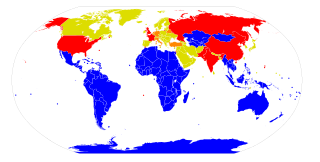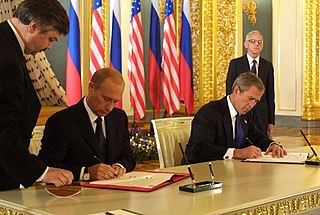 W
WThe Anti-Ballistic Missile Treaty (1972—2002) was an arms control treaty between the United States and the Soviet Union on the limitation of the anti-ballistic missile (ABM) systems used in defending areas against ballistic missile-delivered nuclear weapons. Under the terms of the treaty, each party was limited to two ABM complexes, each of which was to be limited to 100 anti-ballistic missiles.
 W
WThe contracting states to the Comprehensive Nuclear-Test-Ban Treaty (CTBT) are the states that have signed and ratified the international agreement banning all nuclear explosions in all environments. Technically they will not be "parties" until the treaty enters into force, at which point these states will also be Member States of the Comprehensive Nuclear-Test-Ban Treaty Organization (CTBTO), which comes into existence upon entry into force of the treaty. Non-contracting states are also listed, including those that are signatories and those are not. States Signatories are Members of the CTBTO Preparatory Commission.
 W
WThe Lahore Declaration was a bilateral agreement and governance treaty between India and Pakistan. The treaty was signed on 21 February 1999, at the conclusion of a historic summit in Lahore, and ratified by the parliaments of both countries the same year.
 W
WFor the Cold War military alliance, see Baghdad Pact.
 W
WThe National Nuclear Risk Reduction Center is part of the Russian Ministry of Defense, and known also as The Directorate for Control of Agreements' Implementation. It has counterpart in Washington D.C. in the United States Department of State. The main task is the organization of work on the implementation of agreements in the field of Arms reduction and implementation of all the international agreements which were signed by the Russian Ministry of Defence.
 W
WNew START is a nuclear arms reduction treaty between the United States and the Russian Federation with the formal name of Measures for the Further Reduction and Limitation of Strategic Offensive Arms. It was signed on 8 April 2010 in Prague, and, after ratification, entered into force on 5 February 2011. It is expected to last until 5 February 2026, having been extended in 2021.
 W
WThe Non-nuclear aggression agreement is a bilateral and nuclear weapons control treaty between the two South Asian states, India and Pakistan, on the reduction of nuclear arms and pledged not to attack or assist foreign powers to attack on each's nuclear installations and facilities. The treaty was drafted in 1988, and signed by the Prime Minister Benazir Bhutto and her Indian counterpart, Rajiv Gandhi on 21 December 1988; it entered into force on January 1991.
 W
WThe Treaty of Rarotonga is the common name for the South Pacific Nuclear Free Zone Treaty, which formalises a nuclear-weapon-free zone in the South Pacific. The treaty bans the use, testing, and possession of nuclear weapons within the borders of the zone.
 W
WThe Southeast Asian Nuclear-Weapon-Free Zone Treaty (SEANWFZ) or the Bangkok Treaty of 1995, is a nuclear weapons moratorium treaty between 10 Southeast Asian member-states under the auspices of the ASEAN: Brunei Darussalam, Cambodia, Indonesia, Laos, Malaysia, Myanmar, Philippines, Singapore, Thailand, and Vietnam. It was opened for signature at the treaty conference in Bangkok, Thailand, on 15 December 1995 and it entered into force on March 28, 1997 and obliges its members not to develop, manufacture or otherwise acquire, possess or have control over nuclear weapons.
 W
WSTART I was a bilateral treaty between the United States and the Soviet Union on the reduction and the limitation of strategic offensive arms. The treaty was signed on 31 July 1991 and entered into force on 5 December 1994. The treaty barred its signatories from deploying more than 6,000 nuclear warheads and a total of 1,600 intercontinental ballistic missiles (ICBMs) and bombers.
 W
WSTART II was a bilateral treaty between the United States and Russia on the Reduction and Limitation of Strategic Offensive Arms. It was signed by US President George H. W. Bush and Russian President Boris Yeltsin on 3 January 1993, banning the use of multiple independently targetable re-entry vehicles (MIRVs) on intercontinental ballistic missiles (ICBMs). Hence, it is often cited as the De-MIRV-ing Agreement. Despite negotiations, it never entered into effect. It was ratified by the US Senate on 26 January 1996 with a vote of 87–4. Although Russia ratified START II on 14 April 2000, it withdrew from the treaty on 14 June 2002 in response to US withdrawal from the ABM Treaty.
 W
WThe Strategic Arms Limitation Talks (SALT) were two rounds of bilateral conferences and corresponding international treaties involving the United States and the Soviet Union. The Cold War superpowers dealt with arms control in two rounds of talks and agreements: SALT I and SALT II.
 W
WThe Treaty Between the United States of America and the Russian Federation on Strategic Offensive Reductions (SORT), also known as the Treaty of Moscow, was a strategic arms reduction treaty between the United States and Russia that was in force from June 2003 until February 2011 when it was superseded by the New START treaty. At the time, SORT was positioned as "represent[ing] an important element of the new strategic relationship" between the two countries with both parties agreeing to limit their nuclear arsenal to between 1,700 and 2,200 operationally deployed warheads each. It was signed in Moscow on 24 May 2002. After ratification by the U.S. Senate and the State Duma, SORT came into force on 1 June 2003. It would have expired on 31 December 2012 if not superseded by New START. Either party could have withdrawn from the treaty upon giving three months written notice to the other.